.jpg)
View and Read More
A magnificent stronghold was built by an emperor at the end of the 18th century to house his beloved fathers remains.
When Emperor Joengjo of the Joseon Dynasty (1392-1910) moved his father's tomb to Suwon city at the end of the 18th century, he surrounded it with strong defensive works designed by an influential military architect of the period. He erected massive walls that extended for nearly 6km, bastions and artillery towers, all to protect and honor his fathers remains.
Hwaseong Fortress is an outstanding example of early modern military architecture. Embracing the busy downtown area of the present Suwon city (the capital of Gyeonggi province, some 30km south of Seoul), it embodies Jeongjo's devotion to his father and his ideals for a modern administrative and commercial center with stalwart defense.
Hwaseong Fortress is of magnificent size. It spreads out over a widely changing landscape, from high mountain ridges overlooking a crowded urban center to a flatland park to a bustling marketplace surrounded by a densely populated neighborhood. The fortress looks remarkably different from most other ancient town walls and military fortifications scattered across the country. It is notable not only for its diverse functions but also for its visual originality and technical innovation involved in its design and construction.
Visitors are permitted to stroll along the fortress, and one may imagine the hopes and ambitions of the emperor as he built this magnificent fortification to create a robust city and to shield and shelter his city's inhabitants from invaders. For those who are inclined to historical romance, his tragic childhood experience and his noble affection for his parents adds a remorseful color to the excursion along the stronghold, punctuated with crenels and merlons and highlighted by lofty watch towers and secret gates leading down to dark labyrinths.
Korea Tour, Korean Music, Arts, Crafts
- Rest your mind and rejuvenate your soul in the land of the morning calm
- A country renowned for its rich cultural and aesthetic beauty.
- Begin a fantastic journey into the cultural traditions of the past - today!
Korean Traditional Music Station
- Quoted as “the sound that baptizes your soul”
- Unique tempo distribution
- Warm and soft tone color
- Calm and meditative character
- Listen samples
Online Gallery of Korean Arts and Crafts
- High quality pictures and detailed descriptions
- Art essays with in-depth information
- Unique handcrafted gifts
Wednesday, December 29, 2010
Hwaseong Fortress - a splendid battlement with a sorrowful history
Monday, December 13, 2010
Haeinsa Temple Janggyeong Panjeon, the Depositories for the Tripitaka Koreana Wood blocks - incredibly preserved Buddhist texts engraved on wood block
.jpg)
View and Read More
Master craftsmen engraved Buddhist texts onto blocks of wood nearly 800 years ago. They have been remarkably preserved, and are in near perfect condition.
The Temple of Haeinsa on Mount Kaya is home to the Tripitaka Koreana, the most complete collection of Buddhist texts in the world. These texts were incredibly engraved on 80,000 wooden blocks nearly 800 years ago during the Goryeo Dynasty, between the years 1237 and 1248. The buildings of Janggyeong Pangeon were built in the 15th century to house the wood blocks. As the oldest depository of the Tripitaka, the Janggyeong Pangeon reveals an astonishing mastery of the invention and implementation of conservation techniques used to preserve these exceptional works of art.
The World Heritage Committee inscribed this site on the World Heritage List because the Tripitaka Koreana is one of the most important and most complete bodies of Buddhist doctrinal texts in the world. In addition, the buildings in which the scriptures are housed are remarkable as they have preserved these ancient wooden texts against deterioration and disintegration due to age, environmental and weather conditions, insects, etc.
Even though nearly 800 years has been passed since the Tripitaka Koreana was carved, the wooden blocks on which the texts are engraved are in near perfect condition. The wooden blocks and the carefully, devotedly engraved words on them illustrate the superior craftsmanship of the artists.
This engraving of Buddhist manuscripts onto wooden blocks is the oldest example of this type of artwork on Earth. Therefore, these teachings are a wonderful example of Buddhist wisdom and knowledge.
At the same time, the Tripitaka Koreana has greatly influenced the early development of printing and publishing around the globe. Thus, the Tripitaka Koreana is a shining example of both the culture of the Goryeo Dynasty and of Buddhist history, both of which have enlightened the world.
Saturday, December 4, 2010
Royal Tombs of the Joseon Dynasty - structural and natural magnificence to honor the ancestors
.jpg)
View and Read More
The ancient tradition of ancestral worship is perpetuated in modern times through the Royal Tombs of the Joseon Dynasty. Located in areas of sublime beauty, the tombs are sacred structures that inspire devotion.
The Royal Tombs of Joseon Dynasty (1392-1910) are an outstanding example of a type of architectural ensemble that illustrates a significant stage in the development of Korean burial mounds. The royal tombs, with their place in nature and their unique and regularized configuration of buildings and structures, manifest and reinforce the centuries-old tradition and living practice of ancestral worship.
The Royal Tombs of the Joseon Dynasty form a collection of 40 tombs scattered over 18 locations across the country. Built over five centuries, from 1408 to 1966, the tombs honored the memory of ancestors, showed respect for their achievements, asserted royal authority, protected ancestral spirits from evil and provided protection from vandalism. The Joseon Tombs completes the 5,000 year history of royal tombs architecture in the Korean peninsula.
The ensemble of structures that comprise the Royal Tombs features a ceremonial area and an entrance, alongside the burial mounds. In addition, associated buildings that are an integral part of the tombs include a T-shaped wooden shrine, a shed for stele, a royal kitchen and a guards house, a red-spiked gate and the tomb keepers house. The grounds are adorned with a range of stone objects, many featuring figures of people and animals.
The tombs were built in places of outstanding natural beauty, with the back side of the tombs protected by a hill as they face south toward water and, ideally, with mountain ridges visible in the distance.
Within the context of Confucian cultures, the integrated approach of the Royal Tombs of Joseon with nature and the universe has resulted in a distinctive and significant funeral tradition in Korea. The beautiful natural surroundings of the Royal Tombs of the Joseon Dynasty, shaped by the principles of pungsu (feng shui in Chinese), create a delicate, sacred setting for the living tradition of ancestral worship and its associated rites in modern times.
Monday, November 29, 2010
Jongmyo Shrine - a magnificent monument to memorialize Koreas deceased kings
.jpg)
View and Read More
Built in the 16th century, Jongmyo Shrine is a wonderful example of Confucian architecture. Both grand and minimalist, it exudes the dignity and majesty of Koreas deceased kings that it venerates.
Jongmyo is the oldest Confucian royal shrine in Korea and is magnificently preserved to this day. Dedicated to the forefathers of the Joseon dynasty (1392-1910), the shrine was built in the 16th century and houses tablets bearing the teachings of members of the former royal family. Ritual ceremonies linking music, song and dance still take place there, perpetuating a tradition that goes back some 500 years.
In Korean culture (and in many cultures throughout Asia), traditional rites are deemed highly important in modern society to preserve and maintain basic social order. There are a number of important rituals in Korea, the most significant of these being the Jongmyo and the Sajik rituals.
Jongmyo is the term used for a place where memorial services are performed for deceased kings, while Sajik is the term for a place where services for the gods of earth and crops are performed. These symbolic rituals ensure social order and the successful ruling of the nation.
Consequently, due to the significance of these rituals, the Jongmyo and Sajik shrines where these rituals are performed are classic in their architectural grace, detail and beauty. Although such facilities existed in Korea as early as the Three Kingdoms Period (57 B.C.-668 A.D.), those that remain today in Seoul are from the Joseon Dynasty (1392-1910).
Jeongjeon, the main hall, is comprised of 19 identical rooms that are all minimalist in design with no ornamentation. However, the building as a whole is impressive in its grandeur, with 20 thick round pillars boldly projecting the dignity and majesty of royalty. In front of Jeongjeon is a remarkable elevated stone yard called Woldae, which is used during ceremonies by musicians, dancers and other participants. Woldae wonderfully complements the architecture of the main hall, with the large stone blocks comprising the yard creating a striking and solemn atmosphere as they lay in silence before Jeongjeon.
Tuesday, November 23, 2010
Changdeokgung Palace Complex - a splendid palace in harmony with nature
.jpg)
View and Read More
Changdeokgung Palace Complex was built in the 15th century with careful consideration given to its natural surroundings. It is a superb example of a man-made structure blending harmoniously with the beauty of the landscape.
Changdeokgung Palace Complex is an outstanding example of Far Eastern palace architecture and garden design, exceptional for the way in which the buildings are integrated into and harmonized with the landscape, adapting to the topography and leaving the surrounding indigenous trees to grow and flourish in their natural beauty.
During the Joseon Dynasty in the early 15th century, Emperor Taejong ordered the construction of a new palace at an auspicious site, and the Changdeokgung Palace Complex was built. Located in Seoul, it has more structures preserved than any other palace from that period and covers a total area of 580,000 square meters. Consisting of a number of official and residential buildings, the palace complex - including the Secret Garden - was created in a lovely garden space that was cleverly adapted to the uneven topography of the site.
A particularly distinctive feature of Changdeokgung Palace is the fact that it was built with little effect on the natural environment and was designed to be in harmony with nature. Buildings were designed and constructed to blend easily with the immediate surroundings and even directions were given for careful consideration in planning and building. Space was utilized to provide distinctly different yet harmonious views and atmospheres throughout the palace grounds. The result is an exceptional example of Far Eastern palace architecture and design, unifying peacefully with the surrounding landscape.
Thursday, November 18, 2010
Jeju Volcanic Island and Lava Tubes - an extraordinary island of dramatic volcanic landscapes
.jpg)
View and Read More
A popular destination spot for tourists, Jeju Island - with its shield volcanoes, lava tubes and tuff cones - offers visitors a glimpse into the evolution of the Earth's topography.
Jeju Island, the southernmost territory of the Republic of Korea, is renowned the world over for being popular with both domestic and international tourists. A place of unmistakable beauty and one of the finest places in the country to view the splendor of Korea's four seasons, it is also noted for being a volcanic island, bearing testimony to the history of our planet. The island grew up from the sea floor as a result of volcanic activities that began approximately 1.2 million years ago.
There are three main sites on Jeju Island. Geomunoreum is regarded as the finest lava tube system of caves anywhere on the planet, with its multi-colored carbonate roofs and floors, and dark-colored lava walls. The fortress-like Seongsan Ilchulbong tuff cone rising out of the ocean bestows a dramatic landscape. And Mount Hallasan, the highest mountain in South Korea at 1950 meters above sea level, boasts picturesque waterfalls, multi-shaped rock formations, and a lake-filled crater
The diverse volcanic landscapes on Jeju Island, resulting from volcanic activities, are still developing and are well worth visiting. These include the shield volcano, exemplified by those forming around Mt. Hallasan; the small-scale parasitic volcanoes, represented by Seongsan Ilchulbong tuff cone; and the lava tubes formed in the basaltic lava flows. Together, these volcanic features form a significant portion of the world's natural reserve.
Avian and hominid footprint fossils have also been found on Jeju Island. Some of the lava tubes contain artifacts used by prehistoric human beings, and scientists believe these early inhabitants of the island used the lava tubes for shelter or as sacred places.
Friday, November 12, 2010
Seokguram Grotto - an extraordinary Buddhist cave temple built by hand
.jpg)
View and Read More
This phenomenal cave temple houses a large, exquisitely carved Buddha statue looking out to sea. The artificial cave, built on top of a mountain, was constructed using complex mathematical theories 1200 years ago.
Established in the 8th century on the slopes of Mount Toham, the Seokguram Grotto contains a monumental statue of the Buddha in the Bhumisparsha Mudra position looking toward the sea. With the surrounding portrayals of gods, Bodhisattvas and disciples, all realistically and delicately sculpted in high and low relief, it is considered a masterpiece of Buddhist art in the Far East. Together the Seokguram Grotto and the nearby Temple of Bulguksa form a religious architectural complex of exceptional significance.
Overlooking the East Sea from the southeastern tip of the Korean Peninsula, Seokguram stands as a proud testimony to Korea's exceptional tradition of classical Buddhist sculpture. The centuries-old cave temple, enclosing an extraordinary collection of sculptured divinities symbolizing Buddhist philosophy and aestheticism, is a structure of exquisite beauty culminating religious belief, science and fine arts, which flowered in the golden age of Asian art.
Seokguram is located near the summit of Mt. Toham, east of the historic city of Gyeongju, which was the capital of the Silla Kingdom from 57B.C.- A.D.935. Quite remote, it is reached after an hour-long walk up a steep, winding mountain path over some four kilometers from the nearby Temple of Bulguksa.
One of Korea's most popular tourist destinations, Seokguram differs in construction from cave temples in India and China where Buddhism flourished before arriving in Korea. The cave pantheons in India and China were mostly built by digging into hillsides and carving on natural rocks. Instead, at Seokgurm, an incredible artificial cave was created using great granite stones high on the mountain some 750 meters above sea level. The unique architectural technique used to construct Seokguram is unprecedented the world over.
Highlighted by the majestic seated Buddha with a serene, all-knowing expression as the primary object of worship, Seokguram enshrines an impressive assembly of 40 different divinities embodying various aspects of Buddhist teaching. The grotto chapel has an exceptional feeling of peace and harmony resulting in an intense spiritual impression. Modern scientists studying the history of Seokguram have discovered that, aside from the incredible skill needed to handle solid granite, the Silla architects used complex mathematical equations including the geometric theories of the golden rectangle and symmetry to construct the cave temple. Seokguram is an ancient architectural marvel indeed.
Tuesday, November 9, 2010
Bulguksa Temple - a masterpiece of beauty and Buddhist belief
.jpg)
View and Read More
This ancient temple complex is an exquisite example of Far Eastern religious art. It is a survivor: it has endured fire and war, and stands today embodying beauty, grace and equanimity.
The Temple of Bulguksa is the grand centerpiece of a religious architectural complex of exceptional significance. Built in the year 774, Bulguksa has been inscribed on the United Nations Educational, Scientific and Cultural Organization (UNESCO) World Heritage List as a masterpiece of Far Eastern Buddhist art. The temple complex is not only an outstanding example of religious architecture of the region, but also of the material expression of Buddhist belief.
As the name indicates, Bulguksa was designed to be an illumination of the blissful state of the Buddha in the present world. It was intended to embody the happy land where the mortal being is released from the suffering of life by following the teachings of the Buddha or the Lotus Land, as promised in the Avatamsaka Sutra. This embodiment of the Lotus Land offered the theoretical foundation for the construction of the temple. Thus, the purpose of the temple design was two-fold it was to be faithful to the teachings of the Buddha, and it was to be beautiful.
Among the many treasures of Bulguksa, the distinguished pair of pagodas in the main courtyard has a unique and unparalled history. The two dynamic and distinct stone pagodas, standing some 100 feet apart, have survived for over 12 centuries, withstanding the flames of war that engulfed and destroyed all of the temple's original wooden structures. None of the some thousand stone pagodas scattered across Korea excel them for their profound philosophical depth and aesthetic charm. They are a perfect pair, as the princely dignity and simplicity of the Seokga Pagoda dramatically enhances the complexity of the lavishly decorated Pagoda of Many Treasures.
The Seokga Pagoda is also called the "Pagoda without Reflections", denoting the sad legend of Asanyeo, wife of the Baekje mason, Asadal, who built the pagoda. The poor woman came to Gyeongju to see her husband as years had passed without any news from him. As no outsiders were allowed into the holy building site, she was told to wait by a pond near the temple until the completed pagoda cast a reflection in the water. She waited in vain.?No reflection appeared, and she finally threw herself into the pond.
Tuesday, November 2, 2010
World Heritage Tour in Korea: Gyeongju Historic Areas - a unique outdoor museum
.jpg)
View and Read More
This region of the country houses a wonderful collection of Korean Buddhist art from the ancient Silla Kingdom, which can be found both above and below ground.
The Gyeongju Historic Areas encompasses a remarkable concentration of wonderful examples of Korean Buddhist art, in the form of sculptures, reliefs, pagodas, and the remains of temples and palaces, including the renowned Bulguksa Temple and Seokguram Grotto. Gyeongju City and its surroundings have inherited traces of the glory of this unique artistic expression that blossomed and withered in the ancient Silla Kingdom (BC 57 - AD 935).
Excavations of this delightful city and its outer reaches reveal a treasure trove of buried secrets. The ruins of Wolseong, the Half Moon Palace; many temple and fortress sites, including Hwangnyongsa, the Temple of the Yellow Dragon; the exquisite astronomical observatory of Cheomseongdae; huge royal mounds; and ancient wells and bridges have provided a wealth of archaeological data.From royal tombs and palace sites, to stone sculptures and rock-cut reliefs of the Buddha, to pottery buried for more than a millennia, Gyeongju holds thousands of relics within its noble embrace that embody Buddhist teachings and compassion.
The Gyeongju Historic Areas comprises a wealth of beautiful and wondrous artifacts for studying Buddhist culture and the arts of the Far East, as well as for studying the techniques of the ancient kingdoms most talented and gifted craftsmen. This area is considered to be an outdoor museum, where this magnificent collection of beautiful examples of Korean Buddhist art is housed within nature.
Friday, October 29, 2010
Temple Stay: Temple Tour
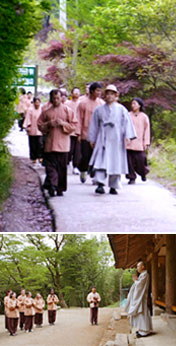
View and Read More
A large number of Korea's cultural assets are Buddhist in nature - more than 65% in fact. Buddhist temples are among the most impressive and comprehensive of these assets, preserving a variety of national cultural assets such as architecture, sculpture, crafts and paintings. These represent religious and artistic creations spanning from the 7th century in the Three Kingdoms Period through the Joseon Dynasty, which ended in 1910.
Temples utilize and display traditional architecture, and house and utilize other historical assets like paintings, Dancheong (Buddhist ways of coloring), Seungmu (Buddhist dancing), and Bumpae (Buddhist music). Korean traditions are maintained by temples as living arts.
Most Korean temples are located deep in the mountains. This is a unique aspect of Korean Buddhist culture. Temples blend harmoniously with their natural environment, enhancing the landscape and embodying serenity. One can feel at peace in such a place, and also experience traditional Korean culture at these sites.
Wednesday, October 27, 2010
Temple Stay: Daily Rites -- Ulyeok (Community Work)
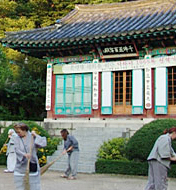
View and Read More
Ulyeok means residents in the temple all work together. Ulyeok represents Korean Seon tradition well. One rule of Seon is a day without work is a day without food. All Korean temples keep this rule, and it is not merely an admonishment, but in the self-sufficient life in a remote Buddhist temple it is an axiom of practicality.
Normally Ulyeok starts after breakfast, and may include farming, cleaning the living quarters or sweeping the courtyard. This is not just physical work, but should be seen as another way of practicing and developing patience and discipline. While not as intensive as Seon meditation, the rhythmic routine of basic work affords a strong foundation for the monks' daily practice.
Also, after meditating, reading sutras, and worship, monks find Ulyeok relaxing. Sweeping autumn leaves from the courtyard or snow from the pathways provides an opportunity to relate quietly with nature and with each other in the community of work. Taking part in Ulyeok is a way for visitors to express gratitude to the hosts, and to join in an important daily ritual.
Sunday, October 24, 2010
Temple Stay: Daily Rites -- Dado (Tea Ceremony)
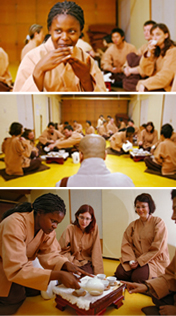
View and Read More
Making and enjoying good tea is one of the practices of the Buddhist religion. Koreans say that there are several ways to enjoy good tea. One should start off by enjoying the sounds of water boiling, and then relaxing with the soothing aroma of tea and seeing its soft and subtle colors. Lastly, one can feel the warmth of the tea radiating through the cup as they slowly savor the taste.
The Korean tradition of drinking tea features neither the formality of Japan nor the popular daily routines of China and the West. It is somewhere in between, with the freedom of being neither totally monastic nor totally secular.
For centuries, Seon meditators have enjoyed tea drinking as a means of reflecting upon themselves, nature, and the principles of the universe. Predecessors have said that tea drinking affords the opportunity to quietly appreciate the tea fragrance, color and beauty; and by striving for truth in this, tea drinking can lead one to the world of enlightenment, thereby making the concentration in tea drinking a form of Seon in itself. This gave rise to the saying, "Seon and tea are the same flavor."
Wednesday, October 20, 2010
Temple Stay: Daily Rites -- Balwoo-gongyang (Communal Buddhist Meal Service)
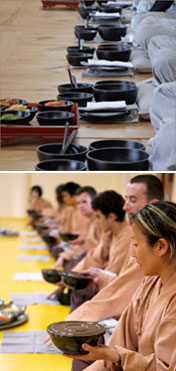
View and Read More
Even taking a meal is part of a monk's religious practice. Before eating, a monk thinks in gratitude of the countless number of people who were involved, directly or indirectly, in the production, processing and preparation of the meal. He also thinks of the endless number of beings suffering from hunger and starvation. And he thinks of the equality and harmony of the community of monks he is sharing the meal with. The true Korean Buddhist meal offering (Balwoo-gongyang, literally "Bowl Offering") is one in which the participant strives to keep in mind the law of interdependence of everything and, consequently, great compassion for all sentient beings.
The meal offering is conducted in the half-lotus position and in total silence, without even the wooden spoons and chopsticks making a sound, and not a single grain of rice is wasted. There is no talking, with the monks chanting being the only words uttered in this stirring ritual.
Sunday, October 17, 2010
Temple Stay: Daily Rites -- Seon (Zen) Meditation
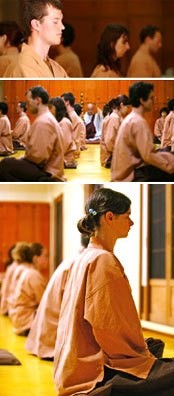
View and Read More
Seon is a form of meditation similar to Zen that allows a person to reflect on oneself. Korea is renowned for retaining this outstanding meditation tradition that continues to flourish today. Korean Buddhism proudly continues the meditation tradition with two 3-month intensive retreats, one in the summer and one in the winter.
All Buddhist traditions include some form of meditation, and Seon is way to practice meditation in Mahayana Buddhism. This meditation brings an end to the 'monkey mind' that we all experience so that our minds become clear and we can return to our original self. There are many other terms for this return to the original self, including enlightenment, awakening, and realizing one's Buddha nature.
Thursday, October 14, 2010
Temple Stay: Daily Rites -- Yebul (Pre-dawn Ceremony)
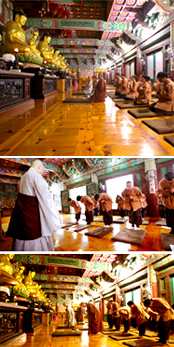
View and Read More
In the pre-dawn darkness, the gentle, rhythmic sound of the Moktak (wooden gong) and the chants of a monk break the silence, awakening everyone within the temple grounds. The melodic chanting is followed by the playing of four larger percussion instruments - the drum, the wooden fish, the cloud gong, and the large bell.
Then, after everyone has filed into the Main Buddha Hall, the pre-dawn homage service begins - chanting to the Buddhas, Bodhisattvas and Predecessors. This ritual has been performed daily in Korean temples for as long as can be remembered. The sound of chanting echoing in the halls of large temples is particularly moving.
Monday, October 11, 2010
What is a Temple Stay?
.jpg)
View and Read More
Temple stays are a unique opportunity for foreign tourists to live in a Buddhist temple and learn about and experience Korean Buddhist culture firsthand. Most temples are located deep in the mountains, so visitors can also fully enjoy the beauty of nature. Through spiritual training such as Seon (Zen) meditation and Buddhist rites, guests achieve the kind of peace of mind that is so needed in the modern world. A temple stay is an enriching experience that recharges the soul and spirit, eases stress, and teaches visitors about traditional Korean Buddhist culture.
The basic program at a temple includes Buddhist rites, Seon meditation, tea ceremonies, and Balwoo-gongyang (Buddhist meal with traditional wooden bowls). There are many other activities to participate in, such as lotus lantern making, impression making with ink and paper, and Buddhist beads threading.
Friday, October 8, 2010
Temple Stay - a spiritual journey in search of serenity

View and Read More
Is your everyday work tough to breathe? Come to Korea and stay in the most beautiful temples in the world. You will find peace of mind and let the stresses of modern life melt away.
Monday, October 4, 2010
Korea Tour
.jpg)
View and Read More
We just launched new tour page on our site. Visit and enjoy this beautiful "land of morning calm," Korea!
Saturday, September 11, 2010
Lacquered wooden tray inlaid with mother of pearl bat design

View More Pictures
Produced after an arduous, time-consuming creating process made only by hand, this octagonal lacquered wooden tray inlaid with mother of pearl bat design exhibits the amazing craftsmanship and artistry of Korean mother of pearl crafts.
The houseware coated with natural lacquer has long been used in East Asia for its glossy beauty as well as its practicality for being strong, watertight and antibacterial.
Thursday, September 9, 2010
Monday, September 6, 2010
Final Drying -- How to create a lacquered wooden tray inlaid with mother of pearl bat design

Seventh drying is the final drying. The artist dries the tray on the wooden drying rack in the shade for a day. It needs a special facility for best drying. The drying house has to be a half-sealed room with no dust at all for drying evenly over the entire surface.
Thursday, September 2, 2010
Sixth Lacquering and Drying -- How to create a lacquered wooden tray inlaid with mother of pearl bat design
Friday, August 27, 2010
Inlaying Mother of Pearl -- How to create a lacquered wooden tray inlaid with mother of pearl bat design
Monday, August 23, 2010
Wet Sanding -- How to create a lacquered wooden tray inlaid with mother of pearl bat design
Thursday, August 19, 2010
Third Drying and Sanding -- How to create a lacquered wooden tray inlaid with mother of pearl bat design
Sunday, August 15, 2010
Thursday, August 12, 2010
Second Sanding and Lacquering -- How to create a lacquered wooden tray inlaid with mother of pearl bat design
Tuesday, August 10, 2010
First Drying -- How to create a lacquered wooden tray inlaid with mother of pearl bat design
Monday, August 9, 2010
How to create a lacquered wooden tray inlaid with mother of pearl bat design -- First Lacquering
Saturday, August 7, 2010
How to create a lacquered wooden tray inlaid with mother of pearl bat design

From today, I will post the process of creating a wonderful wooden tray inlaid with mother of pearl bat design.
It starts with plain wooden tray early made for this. It's uniquely designed octagonal tray. First job is rubbing the surface smooth with sandpaper.
Thursday, July 1, 2010
The Elegance - Haegeum (Korean two-stringed vertical fiddle) Solo by Noh Eun-Ah
.jpg)
Listen to Samples
This album presents original pieces of music presenting the unique tune of Haegeum through the authentic performance by Noh Eun-Ah. Haegeum is a Korean traditional two-stringed vertical fiddle which is one of the representative string instruments used in many traditional Korean musical genres. Each piece features the wonderful harmony between Haegeum's distinctive tone and the melodious background music of western instruments.











